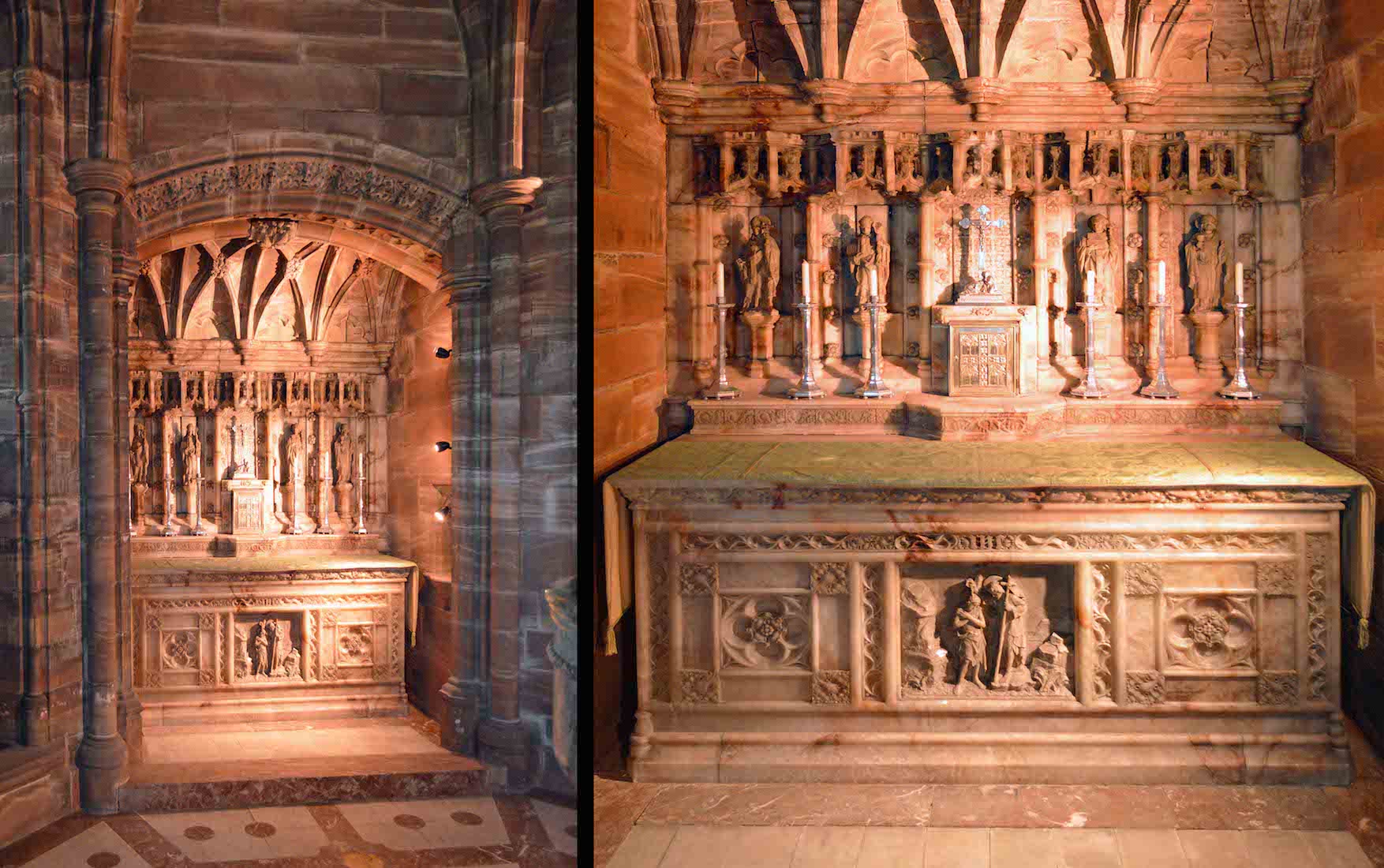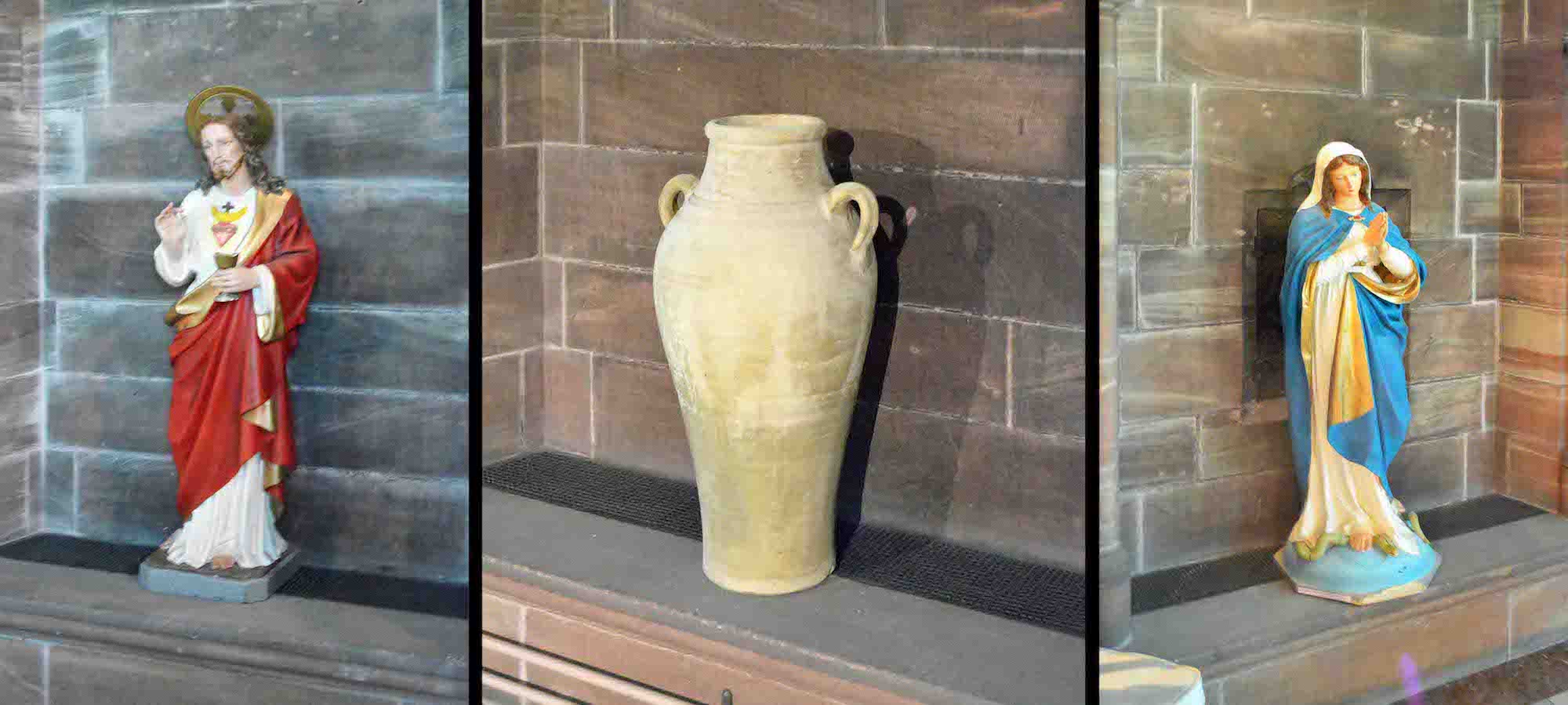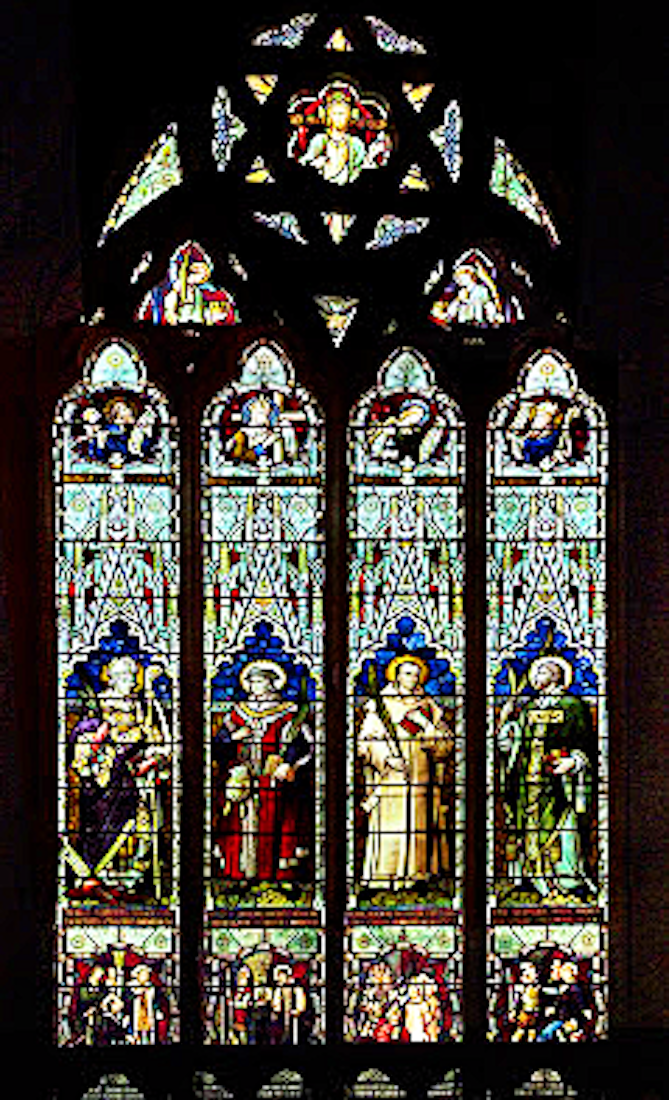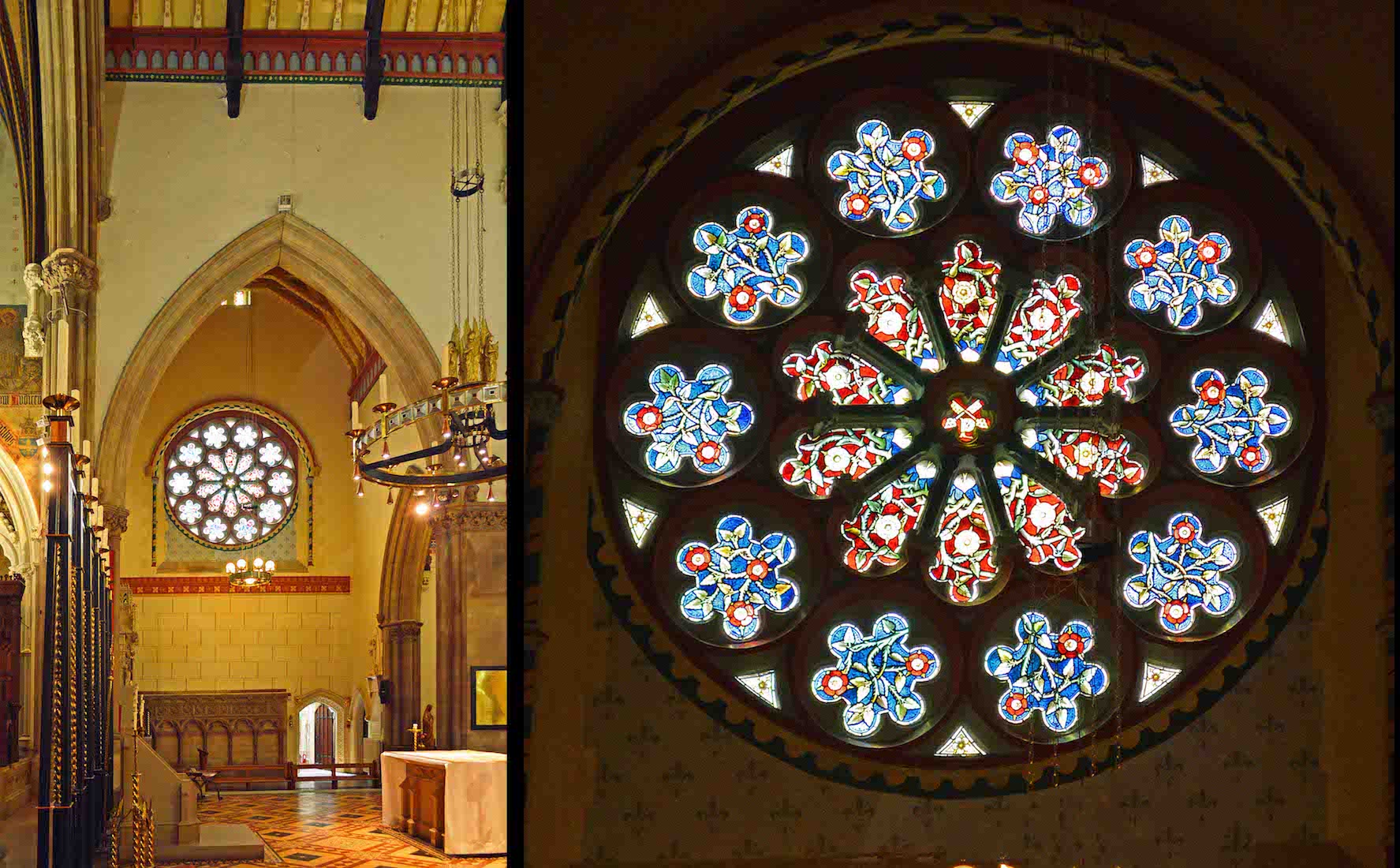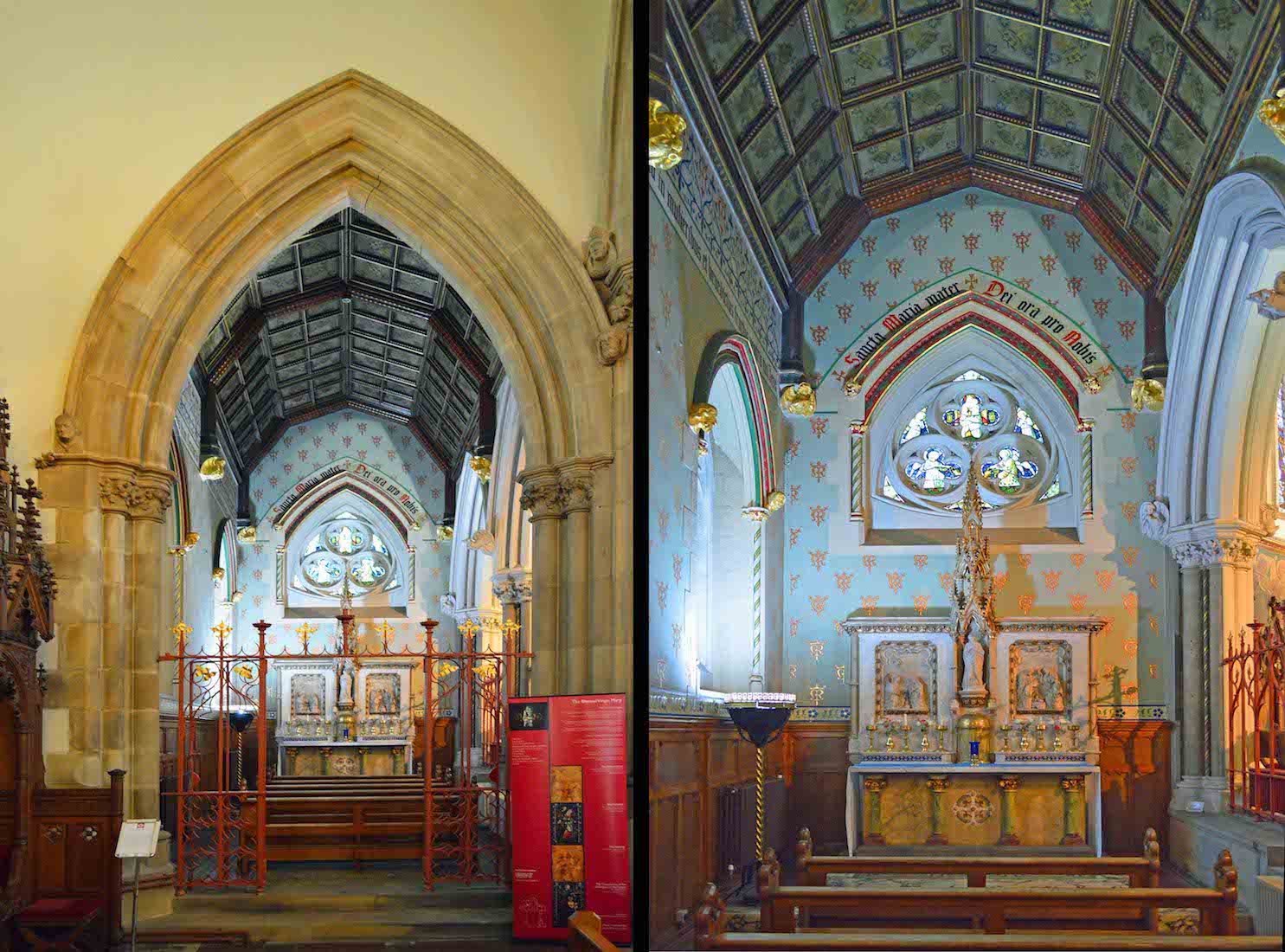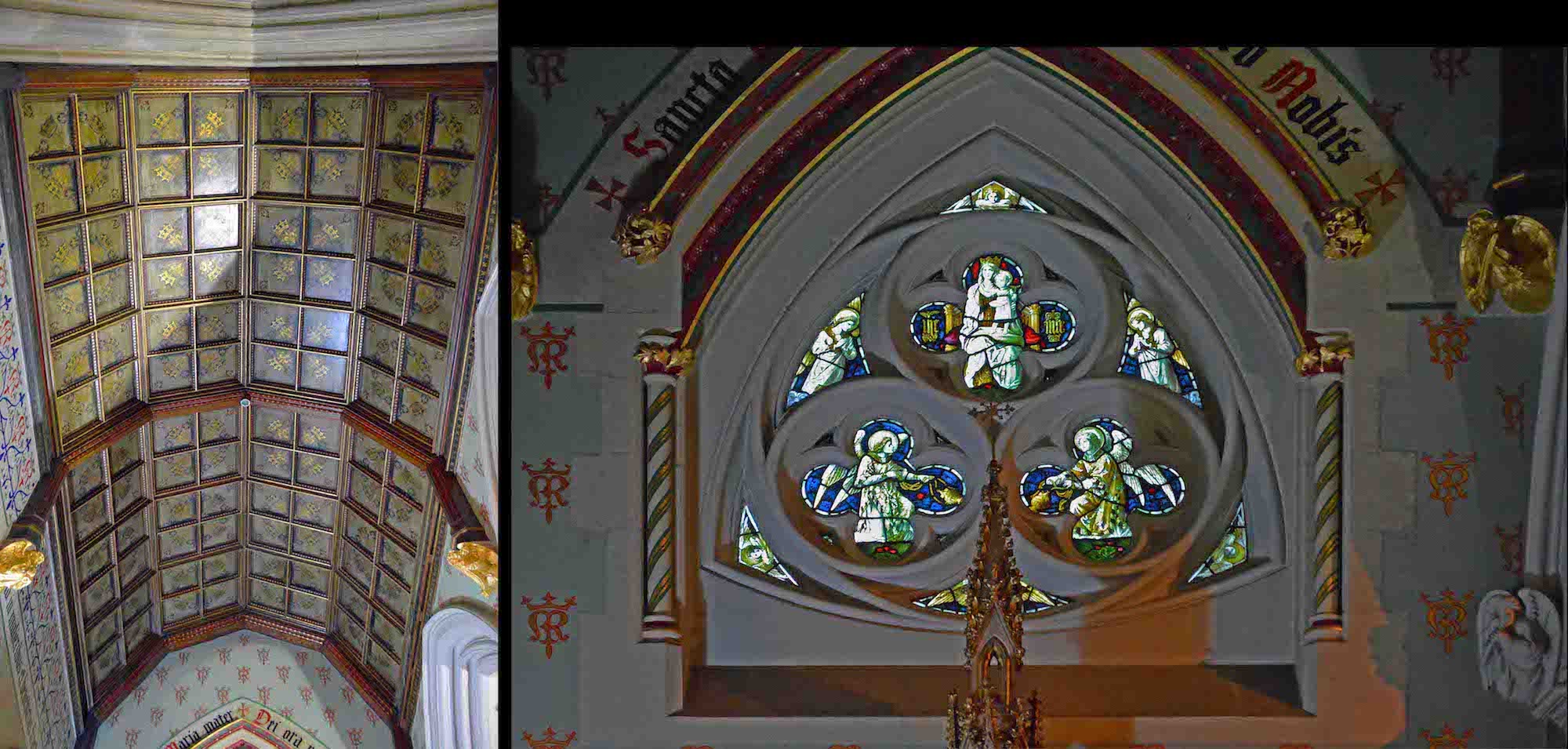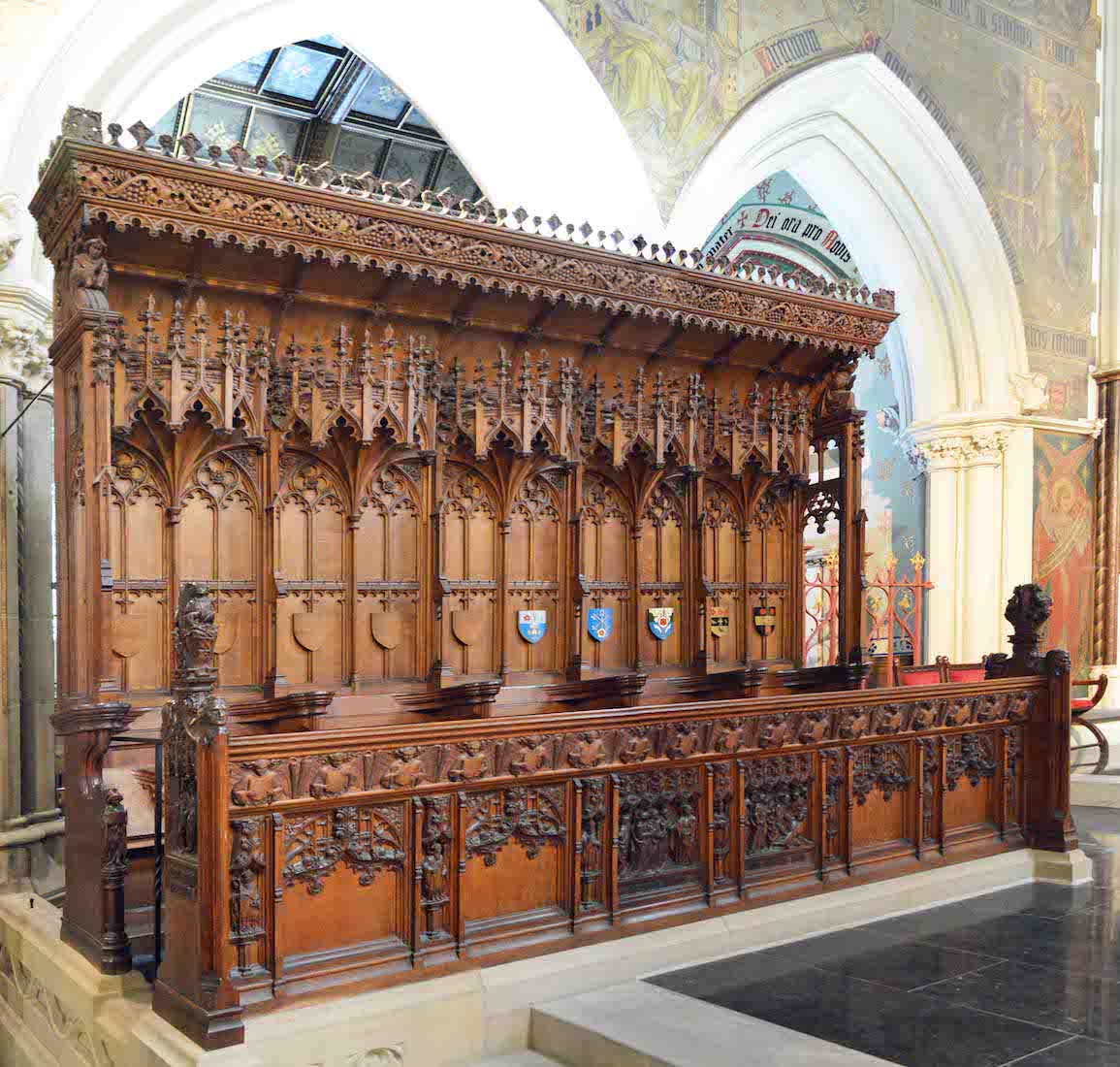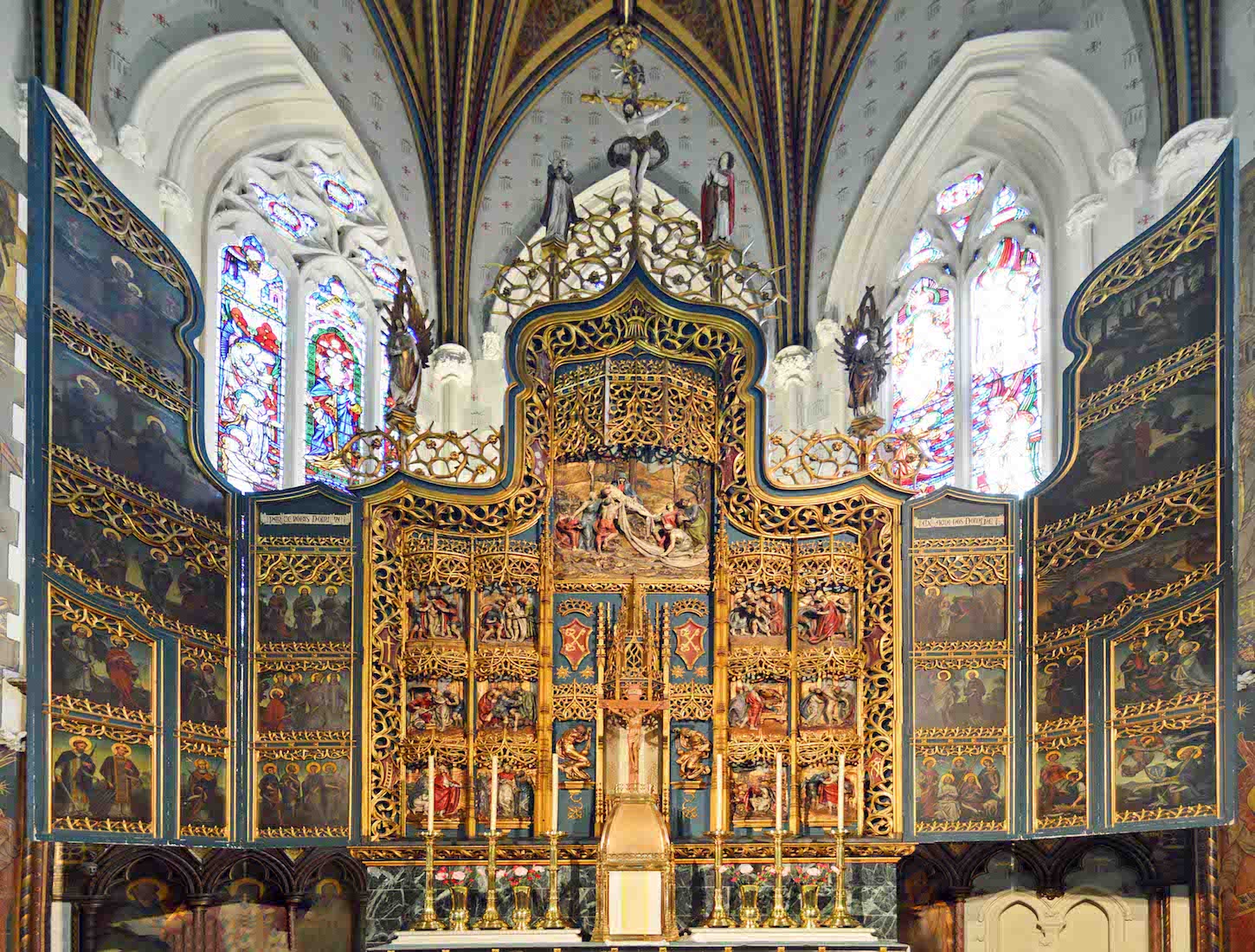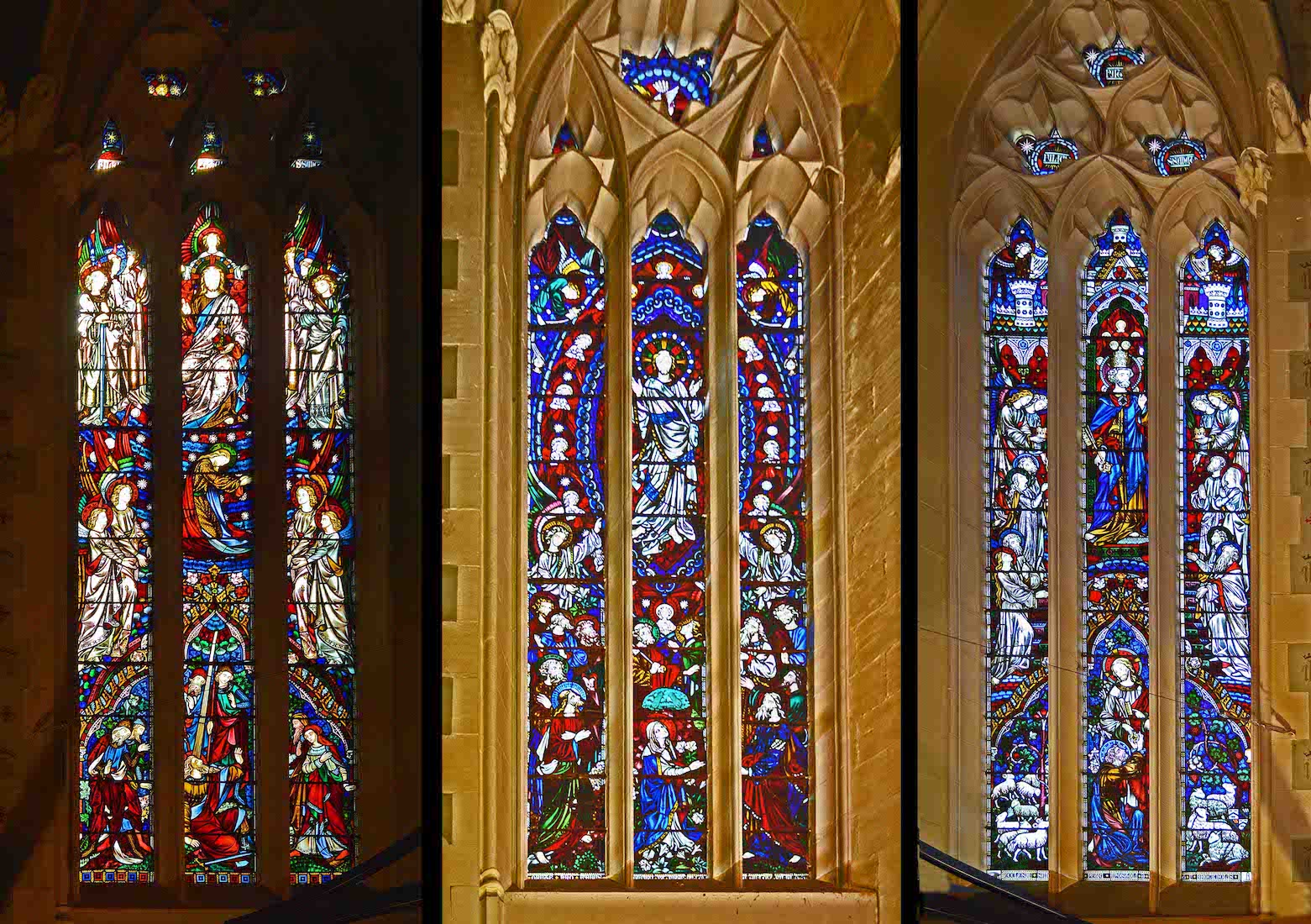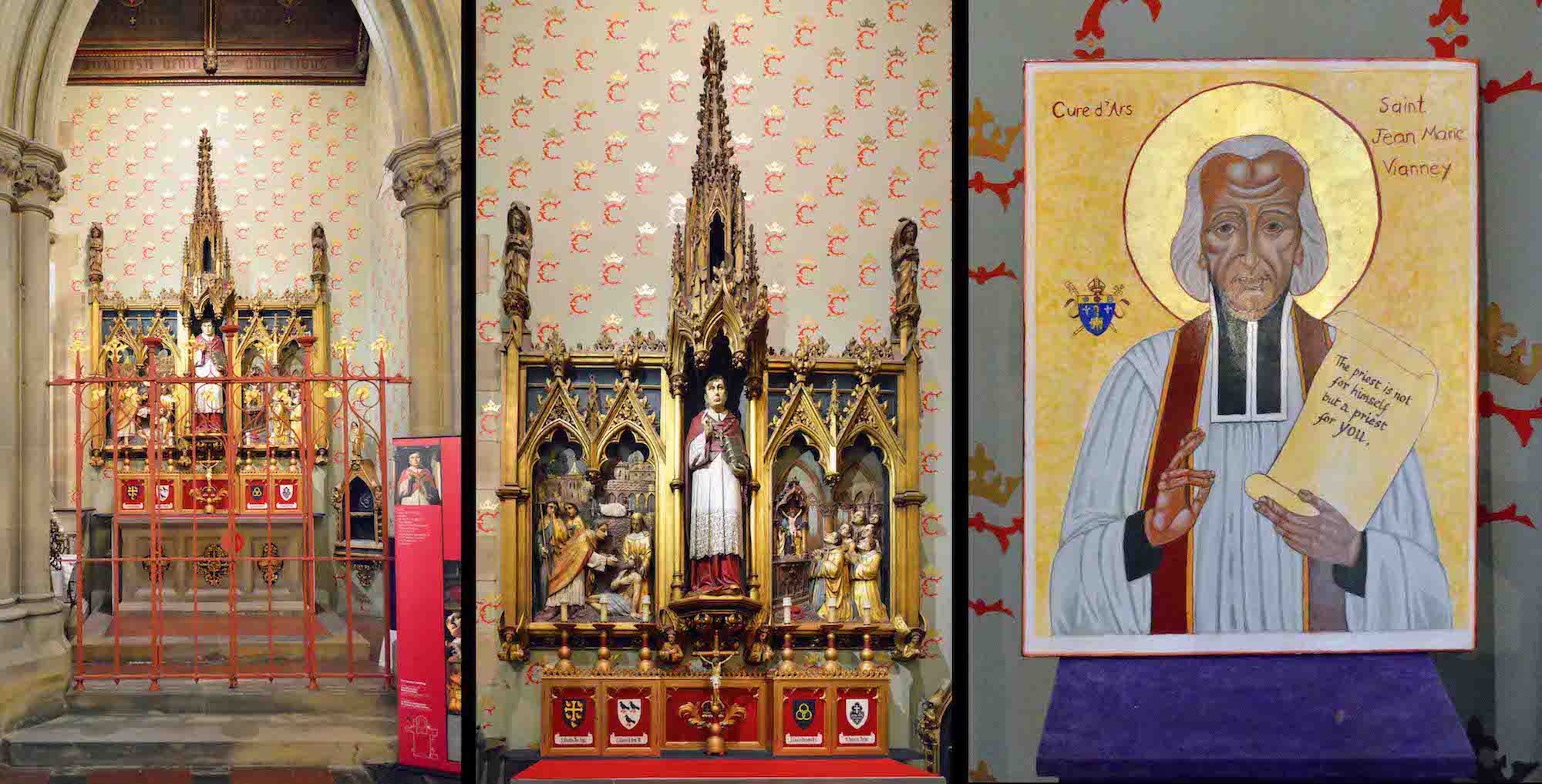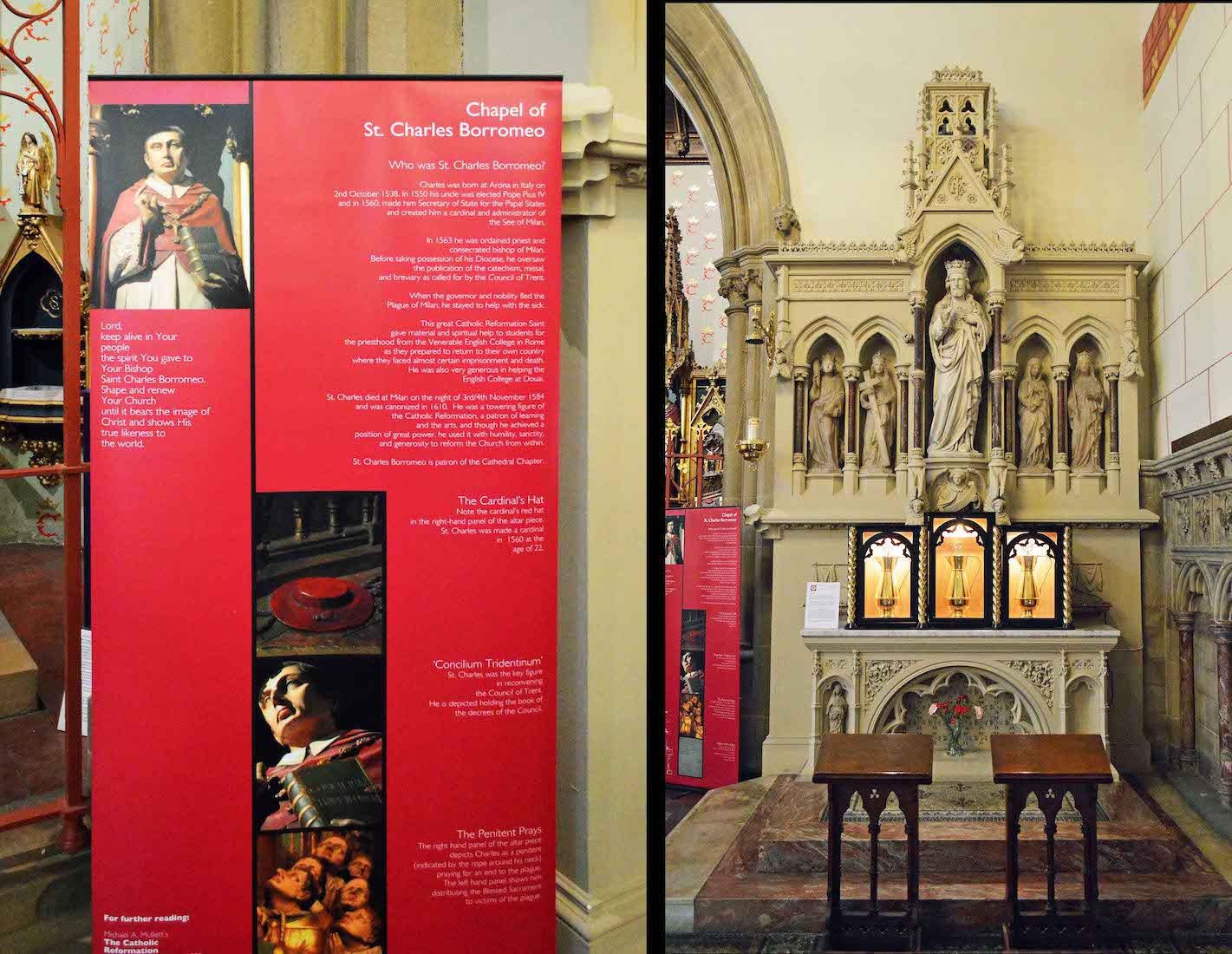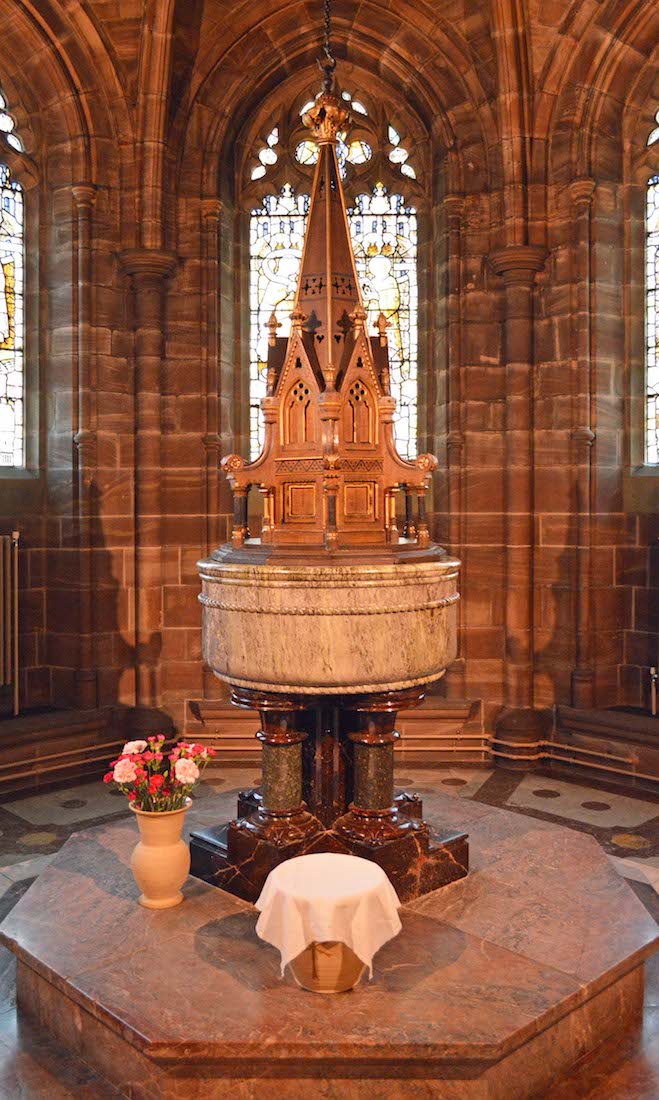
The font is made of Connemara marble. The Latin inscription around it is a quotation from Romans 6:3: ‘For as many as have been baptised in Christ Jesus, are baptised in His death.’ The carved oak canopy over it is raised by a counterweight in the boss of the vaulting. PLAN
42. BAPTISTERY WINDOWS
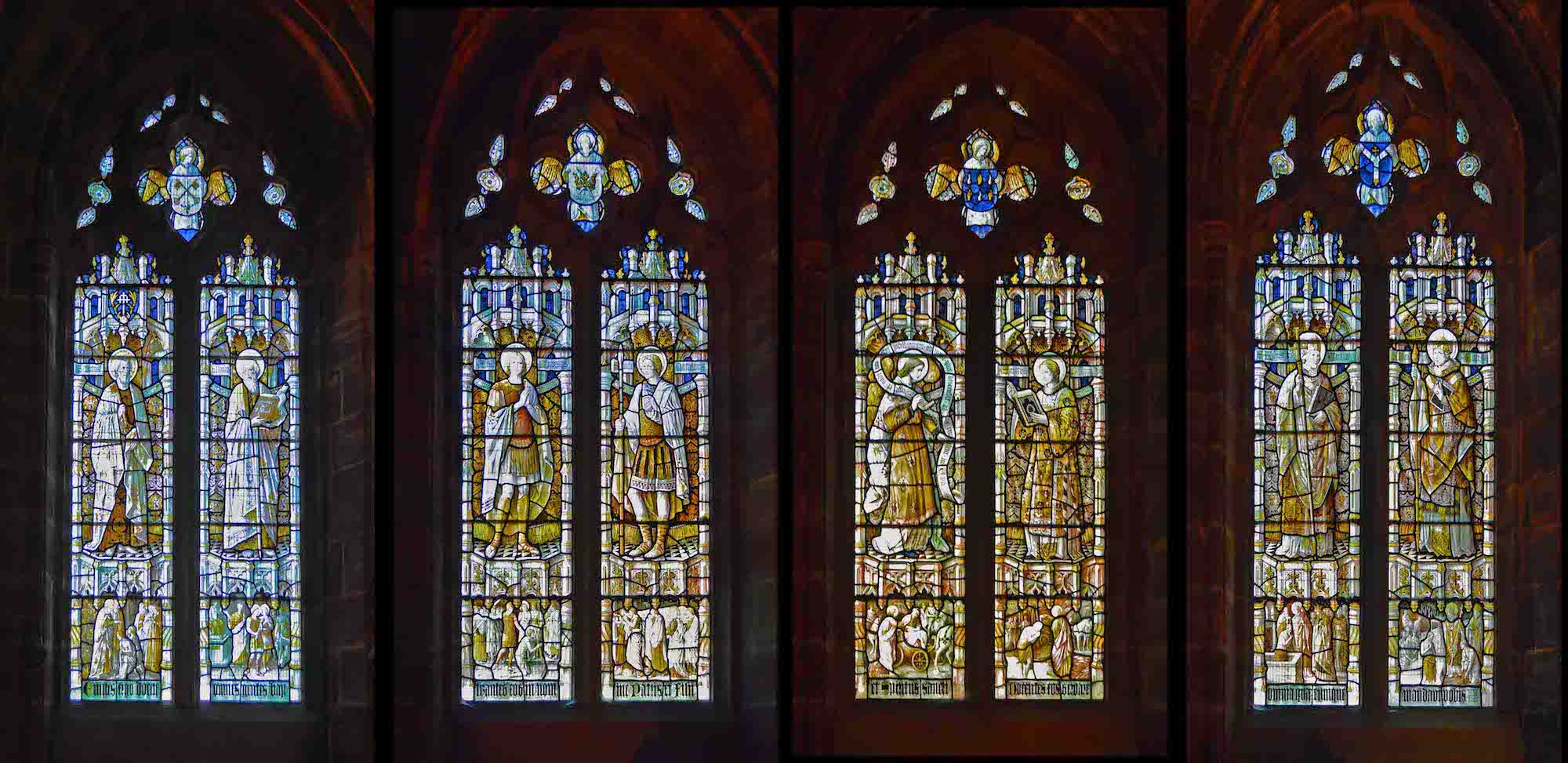
The baptistery windows show the figures of various saints, all with indicated identities! From left we see: St Peter and St Paul; St Processus and St Matimanus (Christian martyrs of ancient Rome); St Phillip(us) and Angel; St Augustine Cantuar (Canterbury) and St Paulinus Ebor (first archbishop of York).
43. BAPTISTERY ALTAR
On the East side of the baptistery is an altar containing relics of the martyrs SS Innocent and Justus. It was consecrated in 1901. The front of the altar has a panel showing the baptism of Jesus. The arcaded reredos contains statues of four saints: Thomas of Canterbury, Chad – Bishop of Mercia, William of York, and Richard of Cheltenham.
44. SACRED HEART, VASE, VIRGIN MARY
These little items can be found in the baptistery. From left, a small Sacred Heart statue; a vase (urn?) which is perhaps used for filling the baptistery; and at right a small statue of the Virgin Mary in prayer.
45. ENGLISH MARTYRS WINDOW
In the North transept is the English Martyrs window, representing St John Fisher, St Thomas Moore, Blessed John Houghton and St Cuthbert Mayne. At the bottom left of the window, King Henry VIII is depicted. He ordered the executions of Fisher and More in 1535. John Houghton (c. 1486 – 1535) was a Carthusian hermit and Catholic priest and the first English Catholic martyr to die as a result of the Act of Supremacy by King Henry VIII of England. Cuthbert Mayne (c. 1543–1577) was an English Roman Catholic priest executed under the laws of Elizabeth I. [Photo Credit: Cathedral photo]
46. LOOKING ACROSS TO THE SOUTH TRANSEPT
At the top of the South transept is the Rose window, inspired by Dante’s Il Paradiso. The Cathedral notes claim that the roses symbolise the graces and virtues of the saints, as seen by the poet in his vision. There appears to be nothing in the design of the individular roses to support this belief. There are also precisely ten roses – a number not generally associated with graces and virtues. I await enlightenment!
47. OLD CATHEDRA
This is the first bishop’s chair, dating from when St Peter’s Church became a Cathedral in 1924. The Latin word for chair or throne is ‘cathedra’, and this is where the (any) cathedral gets its name. The cathedra (along with the canons’ stalls in the Blessed Sacrament Chapel) was a gift of the new diocese, and was made by Waring and Gallow. The shield at right is that of the Lancaster Diocese. The castle represents Lancaster, the fleur-de-lys Mary, the crozier (and mitre above) the bishop.
48. LADY CHAPEL
The Lady Chapel was donated by the Dalton family who lived at Thurnham Hall, near Lancaster. The altar and reredos are made of veined marble. The arch above the circular window has text which reads: Sancta Maria, mater Dei ora pro Nobis (St Mary, Mother of God, pray for us). The back wall is covered with the symbol M with a crown.
49. CHAPEL CEILING AND WINDOW
The ceiling of the Lady Chapel is lined with square panels decorated with the symbol of a crown and a fleur-de-lys: symbol of Mary, Queen of Heaven. The round window shows the crowned Mary holding the Child Jesus.
50. LADY CHAPEL SIDE WINDOWS
The left stained glass window depicts the Visitation, when Mary went to visit her cousin Elizabeth. The window at right shows the Presentation of Jesus in the Temple, where the devout Simeon takes the child and pronounces his well-known Nunc Dimittis: Now dismiss Thy servant, O Lord, in peace, according to Thy word: For mine own eyes hath seen Thy salvation, Which Thou hast prepared in the sight of all the peoples, A light to reveal Thee to the nations and the glory of Thy people Israel.
51. LADY CHAPEL REREDOS
The central statue is an image of Our Lady, the mother of Jesus. The scene on the left depicts the Annunciation; on the right is the birth of Our Lord. Apparently this is the only depiction of the Nativity in the Cathedral, and shows two of the shepherds coming to worship. Is one of them holding a modern hat? Below the figure of Mary is a tabernacle, and a blue light with ‘candle’ (just out of view here).
52. BLESSED SACRAMENT CHAPEL
Behind the iron screen at the back of the sanctuary is the Blessed Sacrament Chapel. Here the Eucharist, the Body of Christ, is kept in the Tabernacle. From here it is taken to those who are sick and unable to attend Mass. Christ is truly present here, so this chapel is a special place of prayer. Before the reordering of the Cathedral in 1995, this chapel with all its magnificence was the main sanctuary. The new arrangement is in keeping with the ruling of Vatican II, but some sense of proportionality seems to have been lost.
53. NORTH CHOIR STALLS
There are two sets of choir stalls which now sit in the Blessed Sacrament Chapel. They are nicely carved. Notice the scene at centre front, various angels and other figures, and at the far end, coloured shields indicating places of rank or position.
54. CHAPEL ALTAR
The altar in the Blessed Sacrament chapel is made of white marble and has an image of the Last Supper on its front. The tabernacle above is made of wrought steel covered with gilded bronze plates. The altar and tabernacle date from the church’s Golden Jubilee in 1909, and were designed by Sir Giles Gilbert Scott.
55. CHAPEL REREDOS
The magnificent triptych above the altar was also added in 1909, and is made up of 32 panels with carved scenes of the Passion, with portraits of the saints and scenes from the bible at the sides. At the top, Our Lady and St John stand at the side of Jesus on the Cross (John 19:26).
56. REREDOS DETAILS
Every part of this triptych is ‘special’, but we choose these two scenes for a closer look. At left is the crucifixion of Christ with a bowed figure on either side. And at right is the scene of the body of Christ being taken down from the Cross – a scene of great emotion and grief much less often portrayed.
57. BLESSED SACRAMENT CHAPEL WINDOWS
The glazing in the apse was in place by 1859. These windows are difficult to photograph (or see!) because of their close proximity to the reredos. In the absence of any explanation these windows (from left) may be portraying: • the Risen Christ, Christ praying in the Garden of Gethsemane, and Saul’s conversion on the Damascus road; • the Risen Christ with Mary and the disciples; • Christ giving the Keys of the Kingdom to Peter, with allusions to the lakeside encounter with Christ’s command to Peter to ‘feed my sheep’.
58. CHAPEL WALL FRESCOES
On either side of the Blessed Sacrament Chapel is a high wall fresco. Christ sits enthroned between the arches to the North, and the crowned Mary with the Christ Child to the South. Above the Christ figure on the North side is a line of women saints; and above the figure of Mary to the South is a line of kings and bishops, also with haloes.
59. CHARLES BORROMEO CHAPEL
The chapel of St Charles Borromeo stands on the South side of the sanctuary. St Charles, a 16th century cardinal, helped many English students for the priesthood, and was a leading figure at the Council of Trent. He was also patron of the local deanery at the time St Peter’s was built. He can be seen in the left panel of the reredos administering Holy Communion to the sick during the plague in Milan in 1576, and in the right panel he is seen praying. The icon is of St John Vianney.
60. ACROSS TO THE SACRED HEART ALTAR
To the right of St Charles’ chapel is the Sacred Heart altar. Both the altar and the statue of the Sacred Heart are made of marble. There are also statues of St Helen, St Frances of Rome, St Catherine of Alexandria and St Margaret of Scotland. The devotion to the Sacred Heart is one of the most widely practiced and well-known Roman Catholic devotions, taking Jesus Christ′s physical heart as the representation of his divine love for humanity.


